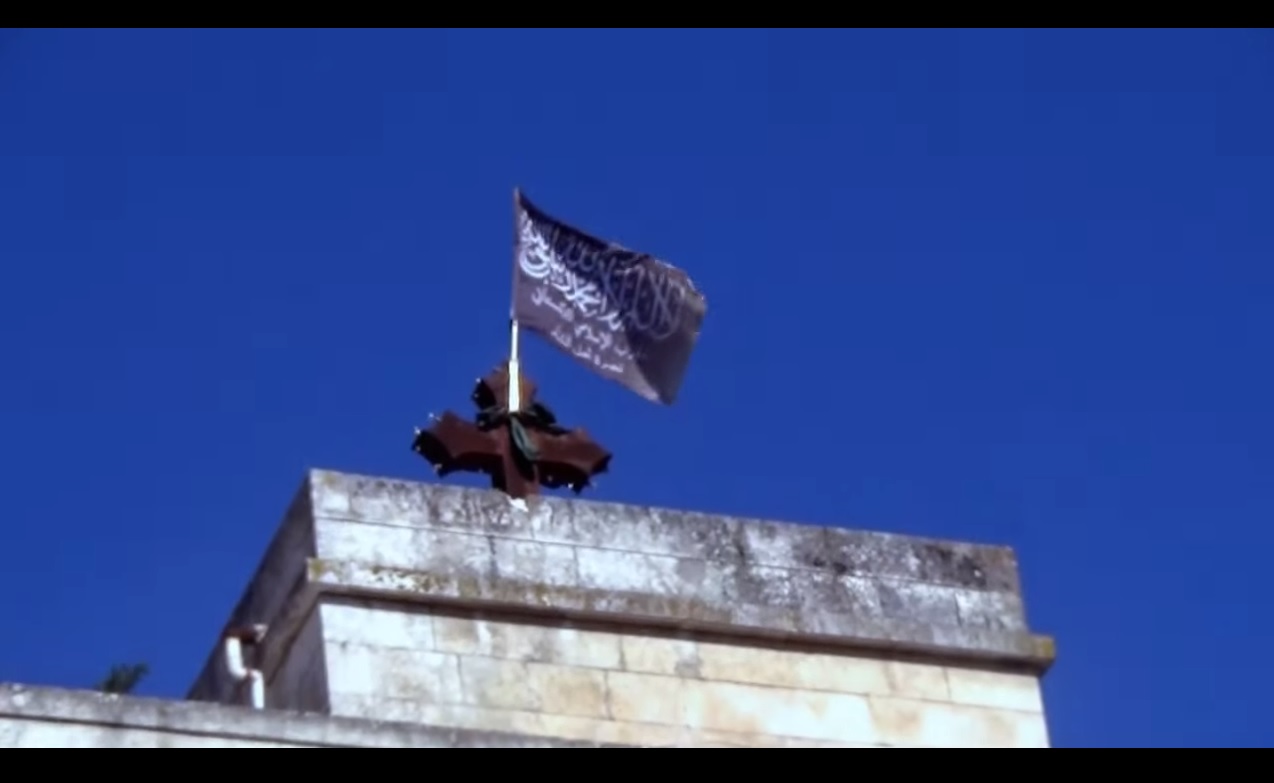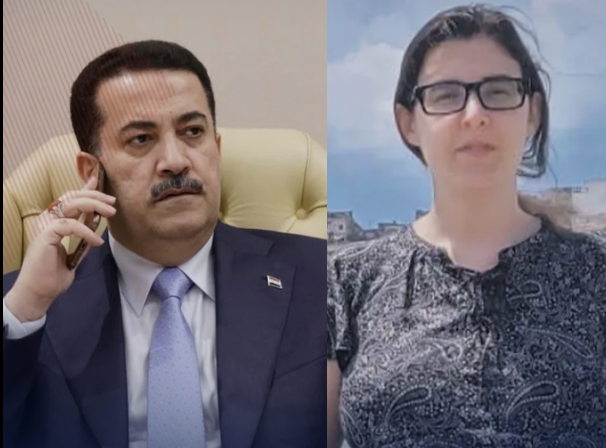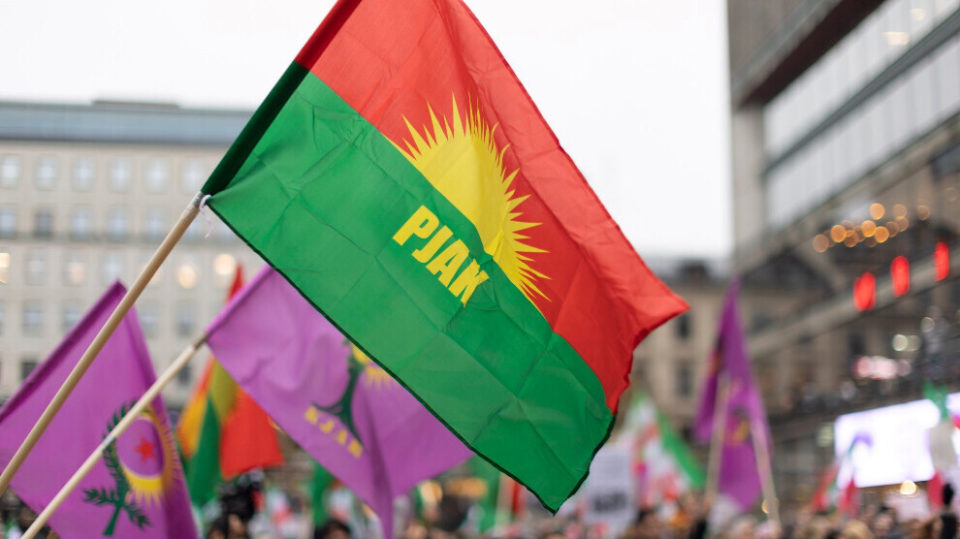
Al-Qaeda-Aligned Central Asian Militants in Syria Separate from Islamic State-Aligned IMU in Afghanistan
Al-Qaeda-Aligned Central Asian Militants in Syria Separate from Islamic State-Aligned IMU in Afghanistan
On April 25, 2015, a coalition of rebel forces led by al-Qaeda affiliate, Jabhat al-Nusra (JN), and including the Uyghur-led Turkistan Islamic Party (TIP) and Uzbek-led Imam Bukhari Jamaat (IBJ) and Katibat Tawhid wal Jihad, defeated the Syrian army in a battle at the strategic town of Jisr al-Shughur in northwestern Syria’s Idlib governorate (YouTube, April 25; Twitter, April 16). Idlib governorate’s capital city, also called Idlib, Jisr al-Shughur and other towns in northwestern Syria fell under rebel control. With Turkey, Qatar and Saudi Arabia supporting this rebel coalition and with a direct supply line open from Turkey’s Hatay Province to Idlib, the rebels may have enough resources to establish a de-facto state in northwestern Syria led by JN and supported by several Central Asian militias (Doha News, April 13).
This de-facto state, which Islamic State condemns for allowing what it describes as jahliyya (pre-Islamic) symbols alongside Islamic ones—such as the blue nationalist flag of “East Turkistan” and the flag of the Free Syrian Army (FSA)—would rival both the Syrian government and the Islamic State, whose territories now encompass most of eastern Syria and western Iraq. For Central Asian countries and China, the emergence of such a de-facto state in northwestern Syria poses a security threat to their countries. Central Asian militant groups in Idlib can potentially take advantage of this safe haven in northwestern Syria to recruit and train fighters and collect funding to support their ultimate goal of creating an Islamic caliphate in Central Asia—a goal not all that different from the Islamic State’s.
Meanwhile, Central Asian militants in the Islamic State-aligned Islamic Movement of Uzbekistan (IMU) are currently shifting from Pakistan into Afghanistan, adopting the Islamic State’s propaganda strategies and working with factions of the Taliban. These Taliban factions, like the IMU, are no longer loyal to Mullah Omar or “constrained” by his demand for fighters to stay within the borders of the Taliban’s Islamic Emirate of Afghanistan (Express Tribune [Karachi], May 8).
Moreover, the emergence of two theaters of war for Central Asian militants in Syria-Iraq and Afghanistan-Pakistan and the relative ease of transit between these two theatres via Turkey heightens the possibility that foreign fighters can return to Central Asia at an opportune moment, such as at a time of political, social or economic unrest.
Thus far, the most significant outcome of the war in Syria and, in particular, the battle at Jisr al-Shughur, for Central Asian militants is their increasing visibility, operational experience and international networks. A safe haven in Idlib would accelerate all three of these trends. This article focuses, in particular, on the TIP and the Uzbek rebel groups, IBJ and Katibat Tawhid wal Jihad, in northwestern Syria and their former ally, the IMU, in Afghanistan and Pakistan.
The Turkistan Islamic Party (TIP) in Jisr al-Shughur
Before the war in Syria commenced, the TIP was mostly based in the Afghanistan-Pakistan border region, where in 2006, it formed its own “brand” among other militant groups, after operating for years under the IMU with sanction from Mullah Umar and al-Qaeda (Kavkaz Center, November 12, 2006; Archive.org, 1999). When the TIP openly announced its support for the rebels in Syria in 2013, in its quarterly Arabic-language online magazine Islamic Turkistan, the TIP became less active in Afghanistan and Pakistan and began to show in its propaganda dozens of fighters in Syria, including their children and wives (Islamic Turkistan, March 2013). While the TIP had up to 300 fighters in Afghanistan and Pakistan, of whom most were Uyghurs and to a lesser extent Turks, Chinese Kazakhs and other Russian-speakers, the TIP’s total numbers in Syria may now reach 1,000 militants, including male fighters and their families (The Friday Times [Lahore], June 8, 2012). [1]
Until the battle at Jisr al-Shughur, the extent of the TIP influence on the battlefield in Syria was difficult to ascertain because most evidence of TIP militancy in Syria came from the TIP’s own propaganda, which could be exaggerated. However, during the battle, several rebel groups filmed TIP fighters combating Syrian government forces, including in candid “homemade-style” videos released on YouTube (YouTube, April 22). The most notable TIP fighter to emerge from the videos in Jisr al-Shughurwas was the Arabic-speaking Abu Ridha al-Turkistani, who has been the spokesman for the TIP’s “Syria branch” since 2014, but also has claimed TIP attacks in China, including a suitcase bombing at Urumqi train station in 2014 and a suicide car bombing at Tiananmen Square in Beijing in 2013 (South China Morning Post, May 14, 2014). In the videos of Abu Ridha al-Turkistani in Jisr al-Shughur, he led fighters to take over a building and climbed a clock tower in the center of the city and placed a black-and-white JN-style flag with “Turkistan Islamic Party” written in Arabic on it (Islom Awazi, May 1).
According to a TIP audio report released after the Jisr al-Shughur battle, which included Uyghur, Hui Chinese, Kazakh and Arabic speakers, the TIP artillery group consisted of “74 mujahideen from Turkistan [likely referring to Uyghurs] and 60 Uzbek, Turk and Arab mujahideen,” while a heavy machine gun group consisted of “seven Turkistan [Uyghur] mujahideen and one Uzbek” (Islom Awazi, May 3). This audio and visual reporting from Jisr al-Shughur taken together therefore suggests a prominent role for the TIP in northwest Syria.
Uzbek Groups in Jisr al-Shughur
Another rebel group to gain prominence in the battle at Jisr al-Shughur is the Uzbek-led Imam Bukhari Jamaat (IBJ). The IBJ and TIP have similar origins under the IMU in Afghanistan and Pakistan, and their respective Uzbek and Uyghur fighters are often shown together in Syria coordinating attacks and speaking in their mutually intelligible Uyghur and Uzbek languages (Sadilarbiz.Blogspot.com, January 16).
The Uzbeks first gained visibility in Syria when they organized under JN in Aleppo in a group then called Seyfuddin Uzbek Jamaat, which was led by a former IMU militant, an Uzbek named Abu Hussein (ChechensinSyria.com, April 14). This jamaat (religious fighting unit) began to receive new Uzbek fighters and evolved into what is now called the IBJ (“Imam Bukhari” was a ninth century Islamic scholar from Bukhara, present-day Uzbekistan). Unlike the TIP, whose “Syria branch” remains united with the TIP leadership in Afghanistan and Pakistan (and intermediaries in Turkey), the IBJ likely broke from the IMU when the IBJ began receiving new recruits independent of the IMU. These recruits were attracted to Syria because of the ease of travel there via Turkey and the theological significance of Syria (or “al-Sham” as it is known in classical Arabic) compared to Afghanistan or Pakistan.
A faction of the IBJ, Katibat Tahwid wal Jihad, is likely comprised almost exclusively of Uzbeks who fight in Syria now, but, unlike IBJ fighters, never fought with the IMU and has no connection to the Afghanistan-Pakistan theater. This katibat (battalion) filmed one of its battles in Jisr al-Shughur. At the end of the battle, the film showed a TIP flag being hoisted on top of a cross of a church (YouTube, May 9). This suggests that Katibat Tahwid wal Jihad and the TIP also operate together.
Growing Alliance Between IMU and Islamic State
The IMU is currently in a state of flux. The IMU has complained about Central Asians “abandoning” Central Asia and Afghanistan in its official statements. IMU fighters have also been forced to leave their long-standing bases in northwest Pakistan and return to northern Afghanistan after successive Pakistani army offensives in late 2014 (Jamia Hafsa Urdu Forum, July 11, 2014; The Nation [Lahore], May 16). As a result of losing Central Asian fighters to al-Qaeda affiliated JN and fleeing from zones where al-Qaeda was active in Pakistan, the IMU’s relationship with al-Qaeda Central has suffered.
In addition, Osama bin Laden’s death in 2011 and the deaths in drone strikes of al-Qaeda and Pakistan Taliban leaders who supported the IMU has weakened IMU relations with al-Qaeda. Moreover, the Taliban under Mullah Omar may also have sidelined the IMU as part of its efforts to gain some level of international and diplomatic legitimacy with a view to reclaiming its place as the government in Afghanistan (Express Tribune [Lahore], December 1, 2014).
Due its alienation from al-Qaeda and the Taliban, the IMU has likely found new synergies with Islamic State, which is seeking to expand its influence in Central Asia, or “Khorasan,” and can provide funding and legitimacy to the struggling IMU. In September 2014, IMU leader Usman Ghazi pledged support to Islamic State leader Abu Bakr al-Baghdadi and criticized the “missing” Mullah Omar, who has not been seen in public since 2001. At roughly the same time as Ghazi’s pledge, several former Taliban factions also pledged loyalty al-Baghdadi (al-Akhbar [Beirut], October 6, 2014). A subsequent IMU statement in April 2015 from Uzbek commander Sadullah Urgenci in Faryab, Afghanistan, and another IMU statement in Dari in May 2015, reaffirmed the IMU’s pledges to al-Baghdadi (Express Tribune [Lahore], April 2). Soon after these pledges, the IMU adopted the Islamic State’s tactics, notably with the IMU undertaking its first propagandized beheadings of Afghan soldiers and kidnappings and beheadings of Shi’a Hazaras in Afghanistan (Tolo News, April 1).
Similarly, the Islamic State’s “Khorasan Province” group claimed its first major attack in Pakistan in Karachi on a bus of Shi’as who were visiting a shrine in April 2015 (Hindustan Times, May 13). The attack was carried out in coordination with Jundallah, the name of the IMU’s media wing and which was an IMU faction created by IMU founder Tahir Yuldashev together with late Pakistan Taliban leader Baitullah Mahsud in South Waziristan in 2008 (AFP, May 13; Asia Times, January 31, 2008). This suggests that the IMU, which has launched several major attacks in Pakistan, including breaking into Bannu prison in 2012, kidnapping and selling U.S. aid worker Warren Weinstein to al-Qaeda in 2013 and raiding Karachi airport in 2014, is playing a key role in spreading the Islamic State’s influence in Afghanistan and Pakistan (Express Tribune [Lahore], June 11, 2014; The News International [Karachi], April 27).
Impact of Islamic State-IMU Relationship
Even though al-Baghdadi has not explicitly recognized Ghazi’s pledge to him, al-Baghdadi has recognized “Islamic State in Khorasan,” which appears to be comprised of several IMU brigades. The IMU’s growing operational and ideological synchrony with the Islamic State will likely widen its rift with the TIP and IBJ in northwestern Syria. The TIP and IBJ are both under the umbrella of JN, and therefore also al-Qaeda, and also maintain their allegiance to Mullah Omar. The TIP in April 2015, for example, expressed “gratitude” to Mullah Omar for respecting what it called the Islamic principle of “friends and foes” and not handing former leader of Uyghur militants in Afghanistan, the late Hassan Mahsum, over to China or the United States after the latter’s invasion of Afghanistan in 2001 (Sadiqlarbiz.Blogspot.com, April 10). The IBJ also released a video of its fighters taking an oath of loyalty to Mullah Omar in November 2014 (RFL/RL, November 12, 2014).
Although most Central Asians in Syria appear to be aligned with JN, the Islamic State has featured several Uzbek, Kyrgyz and Uyghur suicide bombers in Iraq and several dozen Kazakh families in propaganda videos in areas under its control in Iraq (Daily Star [Beirut], March 12). In addition, four Uyghurs were arrested for allegedly trying to meet Islamic State’s affiliate in Sulawesi, Indonesia (Jakarta Globe, March 18). However, overall, the Islamic State appears to be less successful in recruiting Central Asians in Syria and Iraq than it is in expanding its influence into Central Asia, Afghanistan and Pakistan with the IMU and Jundallah.
Conclusion
The rise of Central Asian groups like the TIP and IBJ in northwestern Syria is the most significant development in Central Asian militancy since the rise of the IMU in the Fergana Valley in the mid-1990s and its shift to northern Afghanistan in the late 1990s. Central Asian governments must now deal both with the threat of the “old” IMU in Afghanistan and its “new” derivatives—namely, groups like the TIP and IBJ in Syria. At the same time, because of the prolific activities of the TIP, IBJ and the IMU on the internet, even if governments can succeed in preventing the return of Central Asian fighters to their homelands, these militant groups can still inspire or train fighters there without actually being on-the-ground or face-to-face. The increasing frequency of suicide bombings in Xinjiang, which are not necessarily carried out by the TIP but may be facilitated by its propaganda and online training materials, are an example of what the future may hold for the Central Asian states (South China Morning Post, May 24, 2014).
The Central Asian states are also in a bind insofar as there is little they can do to stymie the growth of the TIP and IBJ in Syria given their lack of influence—and likely also intelligence—there. It is because of this that Kazakhstan’s President Nursultan Nazarbayev, in late 2014, warned of a “worsening geopolitical context” in Eurasia (Eurasia Daily Monitor, November 21, 2014). As such, Central Asian governments will likely need to develop comprehensive national security strategies with allies both within the region and abroad to manage the complexities of emerging threats.
Jacob Zenn is an Analyst of African and Eurasian Affairs for The Jamestown Foundation.
Note
1. Author’s Interviews in Turkey, April 2015.


